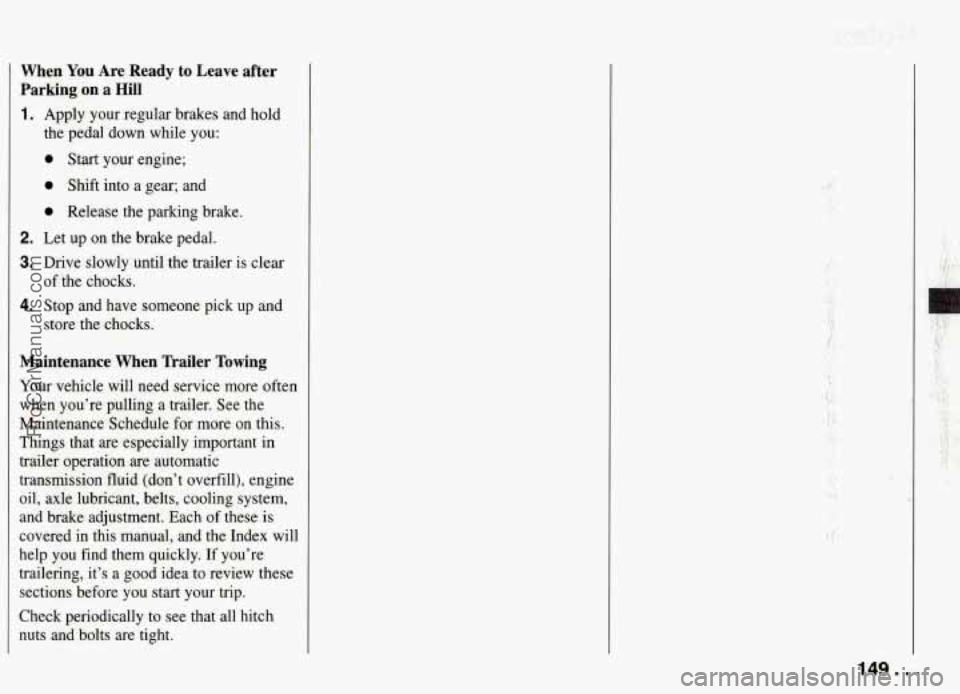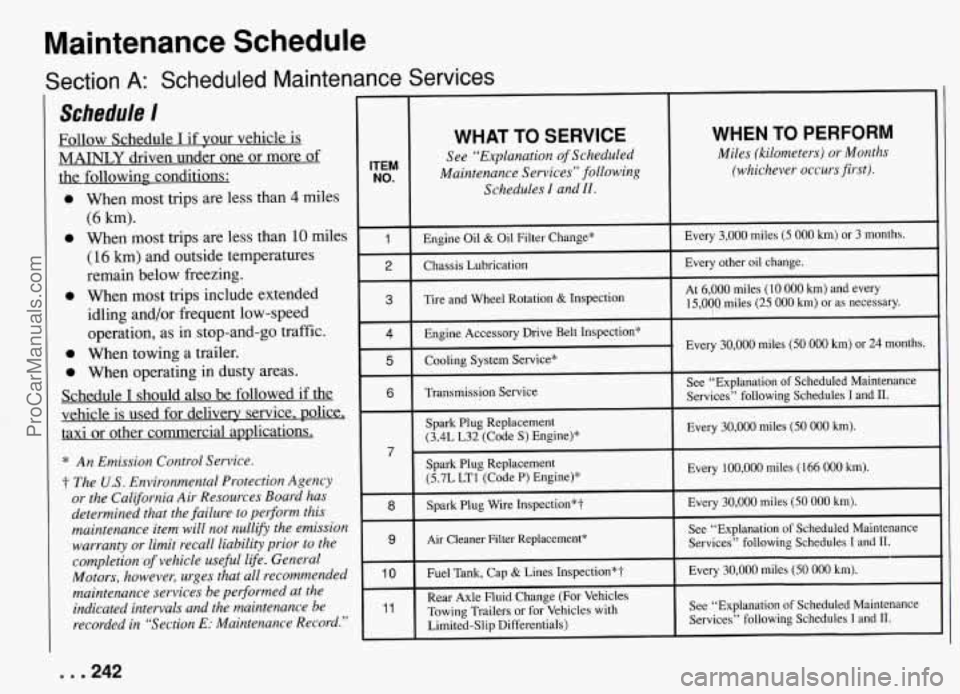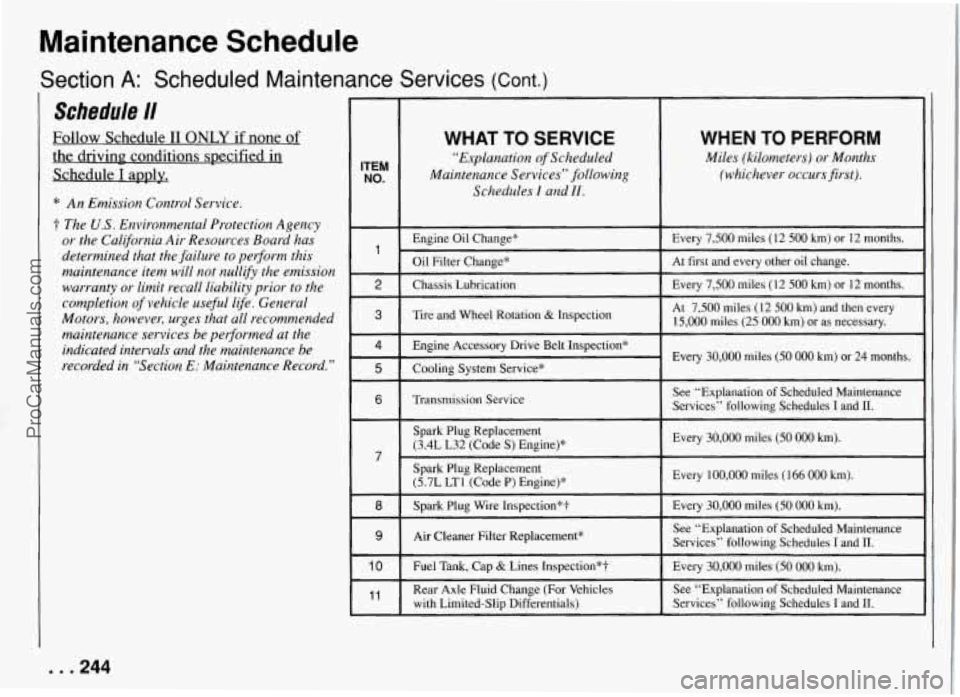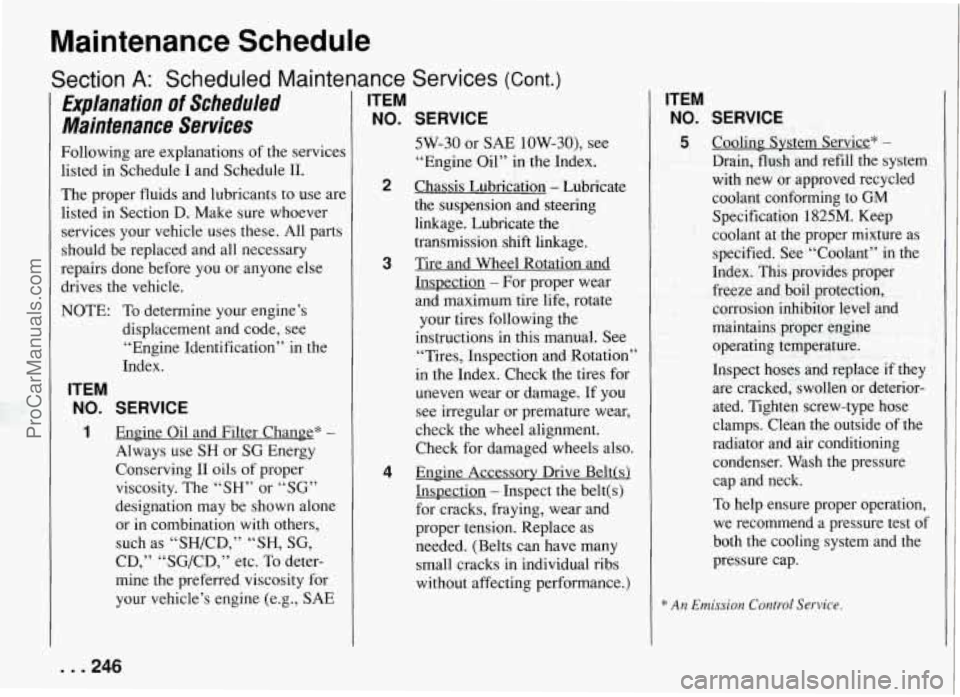belt PONTIAC FIREBIRD 1994 Owner's Guide
[x] Cancel search | Manufacturer: PONTIAC, Model Year: 1994, Model line: FIREBIRD, Model: PONTIAC FIREBIRD 1994Pages: 290, PDF Size: 14.84 MB
Page 134 of 290

Steering in Emergencies
rhere are times when steering can be
.nore effective than braking. For example,
you come over a hill and find a truck
stopped in your lane, or a car suddenly
pulls out from nowhere, or a child darts
out from between parked cars and stops
right
in front of you. You can avoid these
problems by braking
- if you can stop in
time.
But sometimes you can’t; there isn’t
room. That’s the time for evasive action
- steering around the problem.
Your Pontiac can perform very well
in
:mergencies like these. First apply your
)rakes. It is better to remove as much
;peed as you can from a possible
:ollision. Then steer around the problem,
to the left or right depending on the space
available.
An emergency like this requires close
attention and a quick decision. If you are
holding the steering wheel at the
recommended
9 and 3 o’clock positions,
you can turn it a full 180 degrees very
quickly without removing either hand.
But you have to act fast, steer quickly,
and just as quickly straighten the wheel
mce you have avoided the object.
The fact that such emergency situations
xe always possible is a good reason to
practice defensive driving at all times and
wear safety belts properly.
1
3ff-Road Recovery
fou may find sometime that your right
aheels have dropped
off the edge of a
road onto the shoulder
(A) while you’re
hiving.
[f the level of the shoulder
is only slightly
)elow the pavement, recovery shbuld be
Fairly easy. Ease
off the accelerator and
:hen, if there is nothing in the way, steer
$0 that your vehicle straddles the edge of
he pavement. You can turn the steering
wheel up to
114 turn (B) until the:right
kont tire contacts the pavement edge.
rhen
turn your steering wheel to go
;traight down the roadway.
133..
ProCarManuals.com
Page 150 of 290

When You Are Ready to Leave after
Parking on a
Hill
1. Apply your regular brakes and hold
the pedal down while you:
0 Start your engine;
0 Shift into a gear; and
0 Release the parking brake.
2. Let up on the brake pedal.
.
3. Drive slowly until the trailer is clear
4. Stop and have someone pick up and
of the chocks.
store the chocks.
Maintenance When Trailer Towing
Your vehicle will need service more often
when you're pulling a trailer. See the
Maintenance Schedule for more on this.
Things that are especially important in
trailer operation are automatic
transmission fluid (don't overfill), engine
oil, axle lubricant, belts, cooling system,
and brake adjustment. Each of these
is
covered in this manual, and the Index will
help you find them quickly. If you're
trailering, it's a good idea to review these
sections before you start your trip.
Check periodically to see that all hitch
nuts and bolts .are tight.
I
I
149.. .
ProCarManuals.com
Page 219 of 290

Service and Appearance Care
When It’s Time for New Tires
he way to tell when it’s time for new
ires is to check the treadwear indicators,
vhich will appear when your tires have
Inly
2/32 inch (1.6 mm) or less of tread
emaining.
r‘ou need a new tire if:
D You can see the indicators at three or
more places around the tire.
through the tire’s rubber.
or snagged deep enough to show corc
or fabric.
B You can see cord or fabric showing
B The tread or sidewall is cracked, cut
D The tire has a bump, bulge or split.
The tire has a puncture, cut, or other
damage that can’t be repaired well
because of the size or location of the
damage.
Buying New Tires
To find out what kind and size of tires you
need, look at the Tire-Loading
[nformation label.
The tires installed on your vehicle when it
was new had a Tire Performance Criteria
Specification (TPC Spec) number on
each tire’s sidewall. When you get
new
tires, get ones with that same TPC Spec
number. That way, your vehicle will
continue to have tires that are designed
to give proper endurance, handling,
speed rating, traction, ride and other
things during normal service on your
vehicle. If your tires have an all-season
tread design, the TPC number will be
followed by a
“MS” (for mud and snow).
If you ever replace your tires with those
not having a TPC Spec number, make sure they are the same size, load range,
speed rating and construction type (bias,
bias-belted
or radial) as your original
tires.
. . . ZIU
ProCarManuals.com
Page 225 of 290

Service and Appearance Care
Care of Safety Belts
Keep belts clean and dry.
A CAUTION:
Do not bleach or dye safety belts.
If you
do, it may severely weaken
them.
In a crash they might not be
able to provide adequate protection.
Clean safety belts only
with mild
soap and lukewarm water.
Glass
Glass should be cleaned often. GM Glass
Cleaner (GM Part
No. 1050427) or a
liquid household glass cleaner will
remove normal tobacco smoke and dust
films.
Don’t use abrasive cleaners on glass,
because they may cause scratches. Avoid
placing decals on the inside rear window,
since they may have
to be scraped off
later. If abrasive cleaners are used on the
inside of the rear window, an electric
defogger element may be damaged. Any
temporary license should not be attached
across the defogger grid.
Cleaning the Outside of the Windshield
and Wiper Blades
[f the windshield is not clear after using
the windshield washer, or if the wiper
blade chatters when running, wax or
other material may be on the blade or
windshield.
Clean the outside of the windshield with
GM Windshield Cleaner, Bon-Ami
Powder@ (GM Part
No. 1050011). The
windshield is clean if beads do not form
when you rinse it with water.
Clean the blade by wiping vigorously
with a cloth soaked in full strength
windshield washer solvent. Then rinse
the blade with water.
Wiper blades should be checked on a
regular basis and replaced when worn.
Cleaning Twin Lift-off Roof Panels
Special care is necessary when cleaning,
removing and/or storing the roof panels.
0
0
Flush with water to remove dust and
dirt, then dry the panels.
Clean the panels with GM Glass
Cleaner (GM Part
No. 1050427) or
a liquid household glass cleaner.
Leave the cleaner
on the panel for one minute, then wipe the panel with
a soft, lint-free cloth.
0 Don’t use abrasive cleaning materials.
Cleaning the Outside of Your
Pontiac
The paint finish on your vehicle provides
beauty, depth of color, gloss retention and
durability.
Washing Your Vehicle
The best way to preserve your vehicle’s
finish is to keep it clean by washing it
often with lukewarm or cold water.
Don’t wash your vehicle
in the direct
rays of-the sun. Don’t use strong soaps
or chemical detergents. Use .Tiquid hand,
dish or car washing (mild-detergent)
soaps. Don’t use cleaning agents that are
petroleum based, or contain acid or abrasives.
All cleaning agents should be
flushed promptly and not allowed to dry
on the surface, or they could stain. Dry the finish with a soft, clean chamois or
a 100% cotton towel to avoid surface
scratches and water spotting.
High pressure car washes may cause
water to enter your vehicle.
. . .224
ProCarManuals.com
Page 238 of 290

Belt Routing - L32 (Code S) Engine
I
Belt Routing - LTl (Code P) Engine
237. . . ProCarManuals.com
Page 243 of 290

Maintenance Schedule
C L Section A: Scheduled Maintenance Services
Schedule I
Follow Schedule I if your vehicle is
MAINLY driven under one or more of
the following conditions:
When most trips are less than
4 miles
(6 km).
When most trips are less than
10 miles
(16 km) and outside temperatures
remain below freezing.
When most trips include extended
idling and/or frequent low-speed
operation, as in stop-and-go traffic.
When towing a trailer.
When operating in dusty areas.
Schedule
I should also be followed if the
vehicle is used for delivery service. police,
taxi or other commercial aqdications.
* An Emission Control Service.
t The U.S. Environmental Protection Agency
or the California Air Resources Board has
determined that the failure to perform this
maintenance item will not nullify the emission
warranty
or limit recall liability prior to the
completion ‘of vehicle useful life. General
Motors, however, urges that all recommended
maintenance services be performed at the
indicated intervals and the maintenance be
recorded in “Section
E: Maintenance Record.”
ITEM NO.
-
1
3
-
4
6
-
7
9
11
WHAT TO SERVICE
See “Explanation of Scheduled
Maintenance Services” following
Schedules
I and II.
~
Engine Oil & Oil Filter Change*
Chassis Lubrication
Tire and Wheel Rotation
& Inspection
Engine Accessory Drive Belt Inspection*
Cooling System Service*
Transmission Service
Spark Plug Replacement
(3.4L L32 (Code
S) Engine)*
Spark Plug Replacement
(5.7L LTl (Code P) Engine)*
Spark Plug Wire Inspection*?’
Air Cleaner Filter Replacement*
Fuel Tank, Cap
& Lines Inspeclion*t
Rear Axle Fluid Change (For Vehicles
Towing Trailers or for Vehicles with
Limited-Slip Differentials)
WHEN TO PERFORM
Miles (kilometers) or Months
(whichever occursfirst).
Every 3,000 miles (5 000 km) or 3 months.
Every other oil change.
At
6,000 miles (10 000 km) and every
15,000 miles (25 000 km) or as necessary.
Every
30,000 miles (50 000 km) or 24 months.
See “Explanation of Scheduled Maintenance
Services” following Schedules I and
II.
Every 30,000 miles (50 000 km).
Every 100,000 miles (166 000 km).
Every 30,000 miles (50 000 km).
See “Explanation of Scheduled Maintenance
Services” following Schedules I and 11.
Every 30,000 miles
(50 000 km).
~ ~~ ~~~
See “Explanation of Scheduled Maintenance
Services” following Schedules
I and 11.
. . .242
ProCarManuals.com
Page 245 of 290

Maintenance Schedule
Section A: Scheduled Maintenance Services (Cont.)
Schedule lI
Follow Schedule II ONLY if none of
the driving. conditions specified in
Schedule
I apply.
* An Emission Control Service.
t The US. Environmental Protection Agency
or the California Air Resources Board has
determined that the failure to pedorm this
maintenance item will not nullify the emission
warranty or limit recall liability prior to the
completion
of vehicle useful life. General
Motors, however, urges that all recommended
maintenance services be performed at the
indicated intervals and the maintenance be
recorded in “Section
E: Maintenance Record.”
WHAT TO SERVICE WHEN TO PERFORM
“Explanation of Scheduled Miles (kilometers) or Months ITEM NO. Maintenance Services” following (whichever occursfirst).
Schedules
I and I?.
Engine Oil Change* Every 7,500 miles (12 500 km) or 12 months.
Oil Filter Change* At
first and every other oil change. 1
2 Chassis Lubrication Every 7,500 miles (12 500 km) or 12 months. ~~~
3 I Tire and Wheel Rotation & Inspection I
At 7,500 miles (12 500 km) and then every
15,000 miles (25
000 km) or as necessarv.
4 I Engine Accessory Drive Belt Inspection* ~ Every 30,000 miles (50 000 km) or 24 months.
5 I Cooling System Service* !
6 I Transmission Service I
See “Explanation of Scheduled Maintenance
Services” following Schedules
I and 11.
Spark Plug Replacement
(3.4L L32 (Code
S) Engine)* Every 30,000 miles (50 000 km).
7
I
Spark Plug Replacement
(5.7L LTl (Code P) Ennine)* I Every 100,000 miles (166 000 km). \- I I, I
8 Spark Plug Wire Inspection*? Every 30,000 miles (50 000 km).
9 Air Cleaner Filter Replacement* I I
See “Explanation of Scheduled Maintenance
Services” following Schedules
I and II.
10 Fuel Tank, Cap & Lines Inspection”? Every 30,000 miles (50 000 km).
, , Rear Axle Fluid Change (For Vehicles See “Explanation
of Scheduled Maintenance
with Limited-Slip Differentials) Services” following Schedules I and
11.
. . .244
ProCarManuals.com
Page 247 of 290

Maintenance Schedule
Section A: Scheduled Maintenance Services (Cont.)
Explanation of Scheduled
Maintenance Services
Following are explanations of the services
listed in Schedule I and Schedule
II.
The proper fluids and lubricants to use are
listed in Section
D. Make sure whoever
services your vehicle uses these. All parts
should be replaced and all necessary
repairs done before you or anyone else
drives the vehicle.
NOTE: To determine your engine’s
displacement and code, see
“Engine Identification” in the
Index.
ITEM
NO. SERVICE
1 Engine Oil and Filter Change* -
Always use SH or SG Energy
Conserving
I1 oils of proper
viscosity. The “SH” or “SG”
designation may be shown alone
or in combination with others,
such as “SH/CD,”
“SH, SG,
CD,” “SG/CD,” etc. To deter-
mine the preferred viscosity for
your vehicle’s engine (e.g., SAE
ITEM
NO.
2
3
4
SERVICE
5W-30 or SAE 10W-30), see
“Engine Oil” in the Index.
Chassis Lubrication
- Lubricate
the suspension and steering
linkage. Lubricate the
transmission
shift linkage.
Tire and Wheel Rotation and
InsDection
- For proper wear
and maximum tire life, rotate
your tires following the
instructions in this manual. See
“Tires, Inspection and Rotation”
in the Index. Check the tires for
uneven wear or damage. If you
see irregular or premature wear,
check the wheel alignment.
Check for damaged wheels also.
Engine Accessorv Drive Belt!s)
InsDection
- Inspect the belt(s)
for cracks, fraying, wear and
proper tension. Replace as
needed. (Belts can have many small cracks in individual ribs
without affecting performance.)
ITEM
NO. SERVICE
5 Cooling: System Service* -
Drain, flush and refill the system
with new or approved recycled
coolant conforming to GM
Specification 1825M. Keep
coolant at the proper mixture as specified. See “Coolant”
in the
Index. This provides proper
freeze and boil protection, corrosion inhibitor level and
maintains proper engine operating temperature.
Inspect hoses and replace if they
are cracked, swollen or deterior-
ated. Tighten screw-type hose
clamps. Clean the outside of the
radiator and air conditioning
condenser. Wash the pressure cap and neck.
To help ensure proper operation,
we recommend a pressure test of
both the cooling system and the
pressure cap.
* An Emission Control Service.
. . .246
ProCarManuals.com
Page 252 of 290

Section C: Periodic Maintenance Inspections
Listed below are inspections and services which should be performed at least twi\
ce a year (for instance, each spring and fall).
You should let your
GM dealer’s service department or other qualified service center do these jobs. Make sure any necessary
repairs are completed at once.
INSPECTION
I OR SERVICE
Restraint Systems
~ ~~~~
Steering and
Suspension Inspection
Exhaust System
Inspection
Inspection
WHAT SHOULD BE DONE
Now and then, make sure all your belts, buckles, latch plates, retractors, anchorages and
reminder systems are working properly. Look for any loose parts or damage. If you see anything
that might keep a restraint system from doing its job, have it repaired.
Inspect the front and rear suspension and steering system for damaged, loose or missing parts,
signs of wear, or lack of lubrication. Inspect the power steering lines and hoses for proper
hookup, binding, leaks, cracks, chafing, etc.
Inspect the complete exhaust system. Inspect the body near the \
exhaust system. Look for broken,
damaged, missing
or out-of-position parts as well as open seams, holes, loose connections or , ’;;
other conditions which could cause a heat build-up in the floor pan or could let exhaust fumes :~
into the vehicle. See “Engine Exhaust’’ in the Index.
Inspect the throttle linkage for interference or binding, and for damaged or missing parts.
Replace parts as needed.
251 . . .
ProCarManuals.com
Page 270 of 290

ABS ........................ 129
Accessory Power. Retained
....... 52
Add-on Electrical Equipment
..... 228
Adding Coolant
................ 202
Additives. Engine Oil
............ 194
AirBags
...................... 23
How the System Works
........ 24
Servicing Your Air Bag-Equipped
Pontiac
................... 27
Readiness Light
.............. 24
Air Cleaner
.................... 195
Air Conditioner Controls
......... 106
Air Control
Knob ............... 104
Air Filter Replacement
........... 196
Alignment and Tire Balance.
Wheel
...................... 220
Aluminum Wheels
.............. 225
A"M Stereo
With Cassette Tape Player
...... 109
With Cassette Tape Player and
Graphic Equalizer
.......... 1 12
With Compact Disc Player
...... 115
With Compact Disc Player and
Graphic Equalizer
.......... 1 18
Antenna. Fixed Mast
............ 123
Anti-Lock Brakes
.............. 129
To Use ..................... 130
System Warning Light ......... 91
Appearance Care
............... 221
Appearance Care and Materials
.... 227 Appearance Care.
Service and
..... 183
Ashtray and Lighter
............. 85
Ashtray. Front
................. 85
Audio Systems ................. 108
Audio Systems. Comfort
Controls and
................. 103
Automatic Transmission
................ 56
Transmission Fluid
............ 198
Axle. Limited-Slip Rear
.......... 62
Axle. Rear
.................... 201
Babies. Smaller Children
and (Safety Belts)
............. 30
Balance. Wheel Alignment
and Tire
.................... 220
Battery
....................... 208
Battery Replacement. Remote Lock
Control
..................... 45
BBB Auto Line
- Alternative Dispute
Resolution Program.
GM Participation in
......... 261
Before Leaving on a Long Trip
.... 140
Belt Routing
................... 237
Belt. Lap-Shoulder
.............. 19
Bi-Level Heating
............... 105
Blizzard. If You're Caught in a
... 143
Box. Glove
.................... 83
Brakes Adjustment
.................. 208
Anti-Lock
(ABS) ............. 129 Brakes
Fluid
....................... 207
Master Cylinder
.............. 206
Parking
..................... 63
Pedal Travel ................. 207
System Parts. Replacing
........ 208
System Warning Light
......... 90
Trailer ...................... 147
Wear
...................... 207
Braking (Control of a Vehicle)
..... 128
Braking
in Emergencies ........... 132
"Break.In,
.. New Vehicle ........ 50
Brightness Control .............. 76
Bulb Replacement .............. 209
Center High-Mounted
Stoplight
.................. 210
Front Turn Signal
............. 211
Headlights
............. .' .... 209
Rear Lights
.................. 211
Rear Sidemarker
.............. 212
Bulbs, Halogen
................. 209
Bulbs. Replacement
............. 232
Canadian Roadside Assistance
... 263
Capacities and Specifications
...... 233
Carbon Monoxide
.............. 48
Care
Appearance
................. 221
Cassette Tape Player
.......... 122
Compact Discs
............... 122
Safety Belts
................. 224
269 ...
ProCarManuals.com